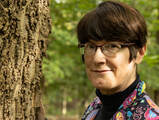| Stories Are Weapons is a chilling account of how military psychological warfare (PSYWAR), also called psychological operations (PSYOPS), are now used routinely to sway US elections—and what we can do to counter these false narratives. "PSYOPS" have been used against American citizens, including campaigns against LGBTQ people, with other eugenic propaganda used against Blacks, and during the Indian Wars of the seventeenth to late nineteenth century. During the Cold War, J. Edgar Hoover targeted homosexuals as “sexual deviants.” This campaign “imperiled the lives of thousands of innocent LGBT Americans.” Although LGBTQ activists have championed the rights of queer people to marry and adopt children, Trans people are being targeted today across the country by radical right extremists. |
“The problem is that eugenics and its modern incarnations are not truly based in science. They are, like all psyops, based on telling emotional stories and appealing to entrenched prejudices.” This hasn’t stopped racist conservative activists from using these false stories to dismantle affirmative action.
| The genocide of Native Americans was propagated on the lie that the American West was “wild and empty.” The author says: “Amateur histories and novels like The Last of the Mohicans touched on a genuine truth—that nations were being decimated—but twisted it [to perpetuate a myth of vanishing Indians], propaganda that helped to sell white settlers on real estate in the West.” When this “war of extermination” became too expensive, “The US Army took Indigenous children away from their families and enrolled them in residential schools that were often hundreds of miles away, making visits and communication impossible. Parents and children might not see each other again for years—if ever.” “The government wanted to turn Indigenous kids from many nations into adults who truly believed in European cultural values and would spread those values in their communities until there were no more Indians.” |
“In 2022, US Secretary of the Interior Deb Haaland released a series of reports on how children in these schools were abused, neglected, and sometimes murdered by the people who were supposedly civilizing them. Like POW camps, Indigenous boarding schools were full of violence and abuse. They were nineteenth century brainwashing machines, institutions that forced kids to accept the ideology and morals of a nation at war with their own.”
| The most frightening section of the book were details of the 2016 and 2020 presidential campaigns. Both presidential election cycles included significant digital propaganda, however “in 2016, a significant number of operations were foreign, but in 2020 most were done by Americans to Americans ... .Ordinary citizens, primed by political leaders to see conspiracies everywhere, spread disinformation as eagerly as paid propagandists.” |
“We’re exposed to ads and marketing from childhood, and that makes us easily played, easily messaged to. Corporations spend millions of dollars on ads because they work. It’s the fastest way to get people to act on their beliefs.”
| Social Science researchers describe people with “authoritarian personalities” as: “cynical about humanity: they believed the strong would always rule the weak and that force was the only way to resolve conflicts. Authoritarians also had deep ethnocentric feelings that led to hatred of all manner of people unlike themselves: Jews, immigrants, homosexuals, political adversaries." "...people with authoritarian leanings often didn’t realize it ...A person might see herself as kindhearted, but clever anti-immigrant propaganda would get her thinking that “those people” are criminals who should be forced into detention camps.” |
“Culture warriors have two goals: convince Americans that some of their fellow citizens are the enemy; and convince ‘the enemy’ that there is something deeply wrong with their minds, and therefore they are not qualified to demand greater freedoms and personal dignity."
| Not all propaganda psywars work. An effort to eradicate the comic book character Wonder Woman in the 1950s as a “a cause of mental illness” was, thankfully, unsuccessful. There are many people working hard to protect Americans against insidious social media propaganda, and people subverting the tools of propaganda to promote positive visions, such as the fabulous Welcome to Leeside, the US's first climate haven. |
“Achieving psychological peace…involves understanding how many of our social institutions are shaped by the stories we’ve heard. It’s about recognizing weaponized stories when they come flying at us, instead of accepting them as factual or unquestionably good. Public policies, fictional tales, and educational materials are all stories that become psyops, aimed at cowing us or changing our behavior. We need to be suspicious of demands that come wrapped in glib narratives.”
Innoculate yourself against psywars before it's too late! Read Stories Are Weapons!































 RSS Feed
RSS Feed